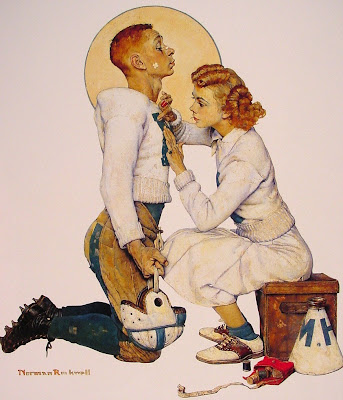Back when I was growing up (a feat I have yet to accomplish) we got our learnin' from books, not some namby-pamby interweb! That was back when I had to walk five miles to school. Uphill. Both ways. Through blizzards and floods. And then when I got there I had to teach myself!
But I digress...
Anyway, when I was studying art I cracked open many a volume about paintings and painters. Most of the books had a small section of poorly colored copies of the artworks, but a larger portion showed the paintings in glorious black and white.
Like this:
Beautiful as this is in black and white, I had no idea it actually looks like this:
Now the reason this painting looks so good whether in color or not, I have come to learn, is all about values. You know-- how light or dark an object is depicted. The editors of those art books from long-ago knew that what made a painting great was how the artist arranged his values. That, plus the artists modeling of paint, along with edge-work and blending could still be seen and appreciated in black and white. Color didn't really matter that much.
Don't believe me? Check out that gorgeous Sorolla at the top of the page. Is it the colors he used or the interplay of lights and shadows that make this a masterpiece? Wanna see it without color?
It still "reads" perfectly! Who needs color? You see, back from almost the beginning days of painting-- say, after the cave paintings of Altamira, but before the 20th Century-- a step that artists would make is called the Grisaille, or monochrome lay-in. The painter back in the day would assess how well his design and composition was by using that step. If the picture looked good in umber, or a gray scale, then it would look OK in color as long as the value of the color matched the value of the grisaille underneath. So it didn't matter if a shadow was blue, brown, red or green or a highlight yellow or pink-- so long as the value was right. Of course, there's more to a painting than that; The artists choice of colors and temperature and how well they handled difficult passages is what separates the best from the rest. But in looking at a painting that looks great reproduced in black and white, you just know that no matter what the color choices are that it is still a damn fine painting.
Let me throw some other examples at you:
This is a lovely pastoral by NC Wyeth.
And I think this is just as good.
I can't forget my buddy Norm:
The above reads just as effectively as the color version below, doesn't it?
But wouldn't every painting look as good in black and white as it would in color?
Nope.
I'll show you:
Here's a Marsden Hartley that's rather colorful--
Take out that color, and it looks like a gray blob:
Below is a painting that I absolutely love. It shows the colors of winter beautifully, and look how the artist uses atmospheric perspective to give it a strong sense of depth.
I mean, I really like this picture! But I wouldn't put this in one of those books I read years ago:
All that sense of depth is gone in black and white.
Now, before you think that I consider my work perfect, let me assure you that I am not immune. Here's one of mine from awhile ago that I still kinda like--
In black and white it looks like a bland Rorshock Test:
Look, I know what you're gonna say next. "But Kev," I can hear you say, "What difference does it make if my painting doesn't look great in black and white? We see in COLOR, you pinhead!"
OK, first off-- lose that attitude! And second, the way I think of it, it's kind of like music; Musicians know that a well constructed song can be played on one instrument. You can sing a song like Yesterday A Capella, on a guitar or piano, or even with spoons-- it doesn't matter, it still sounds good. Now try that with Revolution #9. See the difference? Same with paintings; If the picture is truly well constructed, it'll be just as visually stimulating and interesting in black and white as well as full color.
And that's not all! You can also use black and white to fix some flaws while you're painting. Say you use a nice blue to make those mountains look far away, but yet-- they don't. Try losing color and just assess the value. Maybe that lovely blue is just too dark? And why doesn't my sunny scene look sunny? Again, take a photo of your painting and flip it to black and white. You'll see in an instant what ails your picture.
One final thought: It's not the number of values you use, but where you put them. There are some awesome paintings with less than four values, and masterpieces with a dozen. There are also plenty of duds with a little or a lot of values too. That's what those old black and white tomes were trying to show: It's the artists arrangement of lights and darks that matter, not just the color.
Even those old TV test patterns knew that. Does the pattern look Light, Dark, Light to you?
Guess again.
After all, nothing shows you the truth about color than black and white....
.



+of+mending-the-sail-1896%5B1%5D.jpg)











